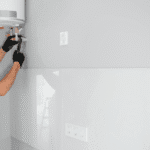In the ever-evolving landscape of healthcare, technological advancements continue to revolutionize various fields, and dentistry is no exception. Traditional dental practices are gradually giving way to innovative approaches, leveraging the power of digital tools and techniques to redefine smiles and transform the patient experience. This intersection of dental care and technology has given rise to the phenomenon known as cyber-dentistry, a realm where digital solutions converge with traditional oral care methods to create more efficient, precise, and personalized treatments. Among the broader societal trends influencing this shift is the growing embrace of transhumanism—the belief in enhancing human capabilities through science and technology—which finds expression in the pursuit of aesthetic perfection, including the quest for the ideal smile.
Table of Contents
The Digital Smile Makeover
For individuals, if you’re unhappy with your smile, whether due to misaligned teeth, discoloration, or other imperfections, the traditional route to improvement often involved lengthy consultations, physical impressions, and multiple visits to the dentist. However, with the advent of cyber-dentistry, this process has been streamlined and enhanced through digital smile makeovers. Utilizing advanced imaging technologies such as digital photography, intraoral scanners, and computer-aided design (CAD), dentists can now create highly accurate virtual models of patients’ smiles.
These digital representations serve as the foundation for comprehensive smile assessments and treatment planning. Patients can visualize potential outcomes and actively participate in decision-making, selecting the precise shade, shape, and alignment of their teeth. This collaborative approach empowers individuals to take control of their dental transformations, ensuring that the end result aligns with their unique preferences and expectations.
Precision and Predictability
One of the key advantages of digital smile redesign is its unparalleled precision and predictability. By harnessing computerized algorithms and simulation software, dentists can meticulously analyze facial aesthetics, occlusal dynamics, and other critical factors to design customized treatment solutions. Whether it involves orthodontic adjustments, dental veneers, or teeth whitening procedures, every aspect of the makeover is carefully calibrated to achieve optimal results.
Moreover, digital workflows enable dentists to anticipate potential challenges and address them proactively, minimizing the risk of complications during treatment. With virtual planning tools and 3D printing technologies, practitioners can fabricate precise restorations and prosthetics tailored to each patient’s unique oral anatomy. This level of accuracy not only enhances the quality of care but also reduces the need for time-consuming adjustments and revisions, expediting the overall treatment process.
Enhancing the Patient Experience
Beyond the clinical benefits, the integration of digital technologies into dental practice has significantly enhanced the patient experience. Gone are the days of uncomfortable impressions and prolonged chairside procedures. With intraoral scanning systems, impressions can be obtained quickly and comfortably, eliminating the need for messy impression materials.
Moreover, digital communication platforms facilitate seamless interactions between patients and dental professionals, enabling remote consultations, appointment scheduling, and treatment updates. This enhanced accessibility and convenience resonate with modern consumers accustomed to digital convenience in every aspect of their lives. By leveraging technology to streamline administrative tasks and minimize wait times, dental practices can cultivate stronger patient relationships and foster greater satisfaction and loyalty.
The Role of Transhumanism
The convergence of cyber-dentistry and transhumanism underscores a broader cultural shift towards embracing technological solutions to enhance human capabilities and aesthetics. As society increasingly prioritizes self-improvement and personalization, the demand for cosmetic dentistry continues to rise. From Hollywood celebrities to everyday individuals, the desire for a flawless smile reflects the aspirational ethos of the transhumanist movement—the relentless pursuit of perfection through scientific innovation.
Moreover, transhumanism challenges conventional notions of beauty and identity, offering a vision of self-expression unconstrained by biological limitations. Through cybernetic enhancements and aesthetic interventions, individuals can transcend the constraints of nature and redefine their physical appearance according to their own standards of beauty and attractiveness. In this context, the digital smile makeover serves as a tangible manifestation of transhumanist ideals, offering individuals the opportunity to sculpt their smiles according to their own visions of perfection.
Looking Towards the Future
As we navigate the ever-expanding frontiers of cyber-dentistry and transhumanism, it is clear that the future of smile redesign is boundless. Continued advancements in digital imaging, artificial intelligence, and biomaterials will further revolutionize the field, unlocking new possibilities for precision, efficiency, and personalization. From virtual reality simulations of dental procedures to bioengineered tooth replacements, the boundaries of what is possible continue to expand.
However, amidst this technological transformation, it is essential to remember the human element at the heart of dental care. While digital tools may enhance our capabilities, they can never replace the compassion, empathy, and expertise of skilled dental professionals. Ultimately, the true measure of success lies not only in the perfection of a smile but also in the satisfaction and well-being of the individual behind it.
In conclusion, the digital revolution in dentistry is reshaping the landscape of smile redesign, offering unprecedented opportunities for precision, predictability, and personalization. By harnessing the principles of cyber-dentistry and transhumanism, we are not only transforming smiles but also redefining the very essence of human beauty and self-expression. As we embark on this journey into the future, let us embrace the possibilities that technology affords while remaining mindful of the values that make us uniquely human.
Apart from this, if you are interested to know more about Advances in Digital Pathology Explained then visit our Technology category
















